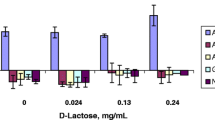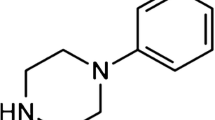Abstract
Purpose
This study used a Box-Behnken experimental design to optimise the experimental conditions in the Caco-2 assay for a series of p-hydroxybenzoate ester compounds (log P 1.96–5.69), as highly lipophilic compounds are not handled well in this system.
Methods
Caco-2 cells, passage 55–70, were cultured on Transwell™ cell culture supports and permeability assays were performed on day 21. A three level three factorial experimental design was used to optimise the experimental conditions.
Results
Addition of BSA (4% w/v) in the medium increased the apparent permeability coefficients (Papp) of each of the parabens except the octyl ester. Increasing the stirring rate by 100 rpm increased Papp for all the parabens. Use of simulated intestinal fluid either increased (fasted state) or decreased (fed state) the Papp of methyl–butyl parabens.
Conclusions
The optimised conditions were; 1.55% w/v BSA, 215 rpm stirring rate and 3.02 mM sodium taurocholate in the simulated intestinal fluid; where octyl paraben (log P 5.69) had an Papp of 33.93 ± 1.84 × 10−6 cm/s, reflecting its rapid absorption in man. This study provides a systematic optimisation of the Caco-2 permeability assay to avoid the underestimation of the intestinal permeability of compounds with log P > 3.




Similar content being viewed by others
References
P. Artursson, K. Palm, and K. Luthman. Caco-2 monolayers in experimental and theoretical predictions of drug transport. Adv. Drug Deliv. Rev. 46:27–43 (2001).
L. S. Gan, and D. R. Thakker. Applications of the Caco-2 model in the design and development of orally active drugs: elucidation of biochemical and physical barriers posed by the intestinal epithelium. Adv. Drug Deliv. Rev. 23:77–98 (1997).
S. Yee. In vitro permeability across Caco-2 cells (colonic) can predict in vivo (small intestinal) absorption in man—fact or myth. Pharm. Res. 14:763–766 (1997).
V. Pade, and S. Stavchansky. Link between drug absorption solubility and permeability measurements in Caco-2 cells. J. Pharm. Sci. 87:1604–1607 (1998).
B. Angelova, and H-P. Schmauder. Lipophilic compounds in biotechnology—interactions with cells and technological problems. J. Biotechnol. 67:13–32 (1999).
P. Augustijns, P. Annaert, P. Hevlen, G. Van der Mooter, and R. Kinget. Drug absorption studies of prodrug esters using the Caco-2 model: evaluation of ester hydrolysis and transepithelial transport. Int. J. Pharm. 166:45–53 (1998).
G. A. Sawada, N. F. H. Ho, L. R. Williams, C. L. Barsuhn, and T. J. Raub. Transcellular permeability of chlorpromazine demonstrating the roles of protein binding and membrane partitioning. Pharm. Res. 11:665–673 (1994).
A. Avdeef, P. E. Nielsen, and O. Tsinman. PAMPA—a drug absorption in vitro model 11. Matching the in vivo unstirred water layer thickness by individual-well stirring in microtitre plates. Eur. J. Pharm. Sci. 22:365–374 (2004).
C. M. Meaney, and C. M. O’Driscoll. A comparison of the permeation enhancement potential of simple bile salt and mixed bile salt:fatty acid micellar systems using the CaCo-2 cell culture model. Int. J. Pharm. 207:21–30 (2000).
F. Ingels, S. Deferme, E. Destexhe, M. Oth, G. Van den Mooter, and P. Augustijns. Simulated intestinal fluid as transport medium in the Caco-2 cell culture model. Int. J. Pharm. 232:183–192 (2002).
F. Ingels, B. Beck, M. Oth, and P. Augustijns. Effect of simulated intestinal fluid on drug permeability estimation across Caco-2 monolayers. Int. J. Pharm. 232:221–232 (2004).
N. Patel, S. Eskola, J. Murray, and B. Forbes. Use of simulated intestinal fluids with Caco-2 cells and rat ileum in Ussing chambers. Drug Dev. Ind. Pharm. 32:151–161 (2006).
J. Karlsson, and P. Artursson. A method for the determination of cellular permeability coefficients and aqueous boundary layer thickness in monolayers of intestinal epithelial (Caco-2) cells grown in permeable filter chambers. Int. J. Pharm. 71:55–64 (1991).
B. J. Aungst, N. H. Nguyen, J. P. Bulgarelli, and K. Oates-Lenz. The influence of donor and reservoir additives on Caco-2 permeability and secretory transport of HIV protease inhibitors and other lipophilic compounds. Pharm. Res. 17:1175–1180 (2000).
G. Krishna, K-J. Chen, C-C. Lin, and A. A. Nomeir. Permeability of lipophilic compounds in drug discovery using in-vitro human absorption model, Caco-2. Int. J. Pharm. 222:77–89 (2001).
P. Saha, and J. H. Kou. Effect of bovine serum albumin on drug permeability estimation across Caco-2 monolayers. Eur. J. Pharm. Biopharm. 54:319–324 (2002).
Y. Nakagawa, and P. Moldeus. Mechanism of p-hydroxybenzoate ester-induced mitochondrial dysfunction and cytotoxicity in isolated rat hepatocytes. Biochem. Pharmacol. 55:1907– 1914 (1998).
E. J. Routledge, J. Parker, J. Odum, J. Ashby, and J. P. Sumpter. Some alkyl hydroxy benzoate preservatives (parabens) are estrogenic. Toxicol. Appl. Pharmacol. 153:12–19 (1998).
P. D. Darbre, A. Aljarrah, W. R. Miller, N. G. Coldham, M. J. Sauer, and G. S. Pope. Concentrations of parabens in human breast tumours. J. Appl. Toxicol. 24:5–13 (2004).
R. Golden, J. Gandy, and G. Vollmer. A review of the endocrine activity of parabens and implications for potential risks to human health. Crit. Rev. Toxicol. 35:435–458 (2005).
R. Ragonese, M. Macka, J. Hughes, and P. Petocz. The use of Box-Behnken experimental design in the optimisation and robustness testing of a capillary electrophoresis method for the analysis of ethambutol hydrochloride in pharmaceutical formulation. J. Pharm. Biomed. Anal. 27:995–1007 (2002).
M. Lakeram, D. J. Lockley, D. J. Sanders, R. Pendlington, and B. Forbes. Paraben transport and metabolism in the biomimetic artificial membrane permeability assay (BAMPA) and 3-day and 21-day Caco-2 cell systems. J. Biomol. Screen 12:84–91 (2007).
K. S. Singh, J. Dodge, M. J. Durrani, and M. A. Khan. Optimisation and characterisation of controlled release pellets coated with an experimental latex. I. Anionic drug. Int. J. Pharm. 125:243–255 (1995).
A. A. Karnschi and M. A. Khan. Box-Behnken design for optimisation of formulation variables of indomethacin coprecipitates with polymer mixtures. Int. J. Pharm. 131:9–17 (1996).
P. Artursson. Epithelial transport of drugs in cell culture. I. A model for studying the passive diffusion of drugs over intestinal absorptive (Caco-2) cells. J. Pharm. Sci. 79:476–482 (1990).
P. Wils, A. Warnery, V. Phung-Ba, S. Legrain, and D. Scherman. High lipophilicity decreases drug transport across intestinal epithelial cells. J. Pharmacol. Exp. Ther. 269:654–658 (1994).
H. Lennernas. Human intestinal permeability. J. Pharm. Sci. 87:403–410 (1998).
I. J. Hidalgo, K. M. Hillgren, G. M. Grass, and R. T. Borchardt. Characterisation of the unstirred water layer in Caco-2 cell monolayers using novel diffusion apparatus. Pharm. Res. 8:222–227 (1991).
K. Naruhashi, I. Tamai, Q. Li, Y. Sai, and A. Tsuji. Experimental demonstration of the unstirred water layer effect on drug transport in Caco-2 cells. J. Pharm. Sci. 92:1502–1508 (2003).
C. K. Pease, J. Kino-Thompson, D. Sanders, R. U. Pendlington, M. York, A. McEwan, S. G. Wood, A. Peters, D. Griffiths, G. Ford, and K. Dummer. Biokinetic equivalence of propylparaben and octylparaben: in vitro metabolism data and single dose oral administration study in man. Drug Metab. Rev. 38:S1 (2006).
Acknowledgements
Mark Lakeram was funded by a Biotechnology and Biological Sciences Research Council CASE award and Unilever Colworth, UK.
Author information
Authors and Affiliations
Corresponding author
Rights and permissions
About this article
Cite this article
Lakeram, M., Lockley, D.J., Pendlington, R. et al. Optimisation of the Caco-2 Permeability Assay Using Experimental Design Methodology. Pharm Res 25, 1544–1551 (2008). https://doi.org/10.1007/s11095-008-9556-9
Received:
Accepted:
Published:
Issue Date:
DOI: https://doi.org/10.1007/s11095-008-9556-9




